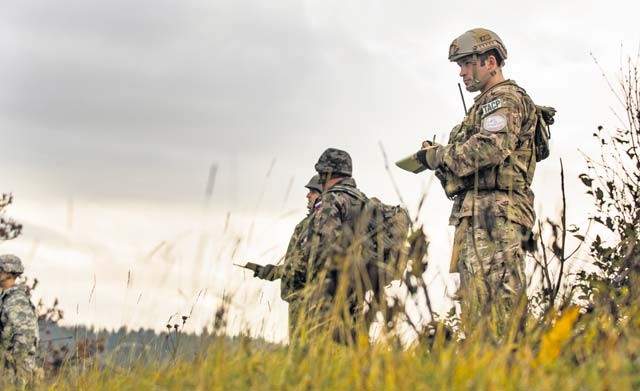
POSTOJNA, Slovenia — U.S. service members watched as precision-timed artillery and machine guns suppressed “enemy” positions while a Slovenian aircraft middive released munitions.
Airmen from the 435th Air Ground Operations Wing joined exercise Rock Proof V at the Pocek Training Range, Slovenia, bringing joint terminal attack controllers to coordinate and deliver close air support.
“What we bring to the fight allows the (U.S.) Army to better execute its mission,” said Staff Sgt. Therron Bundick, 2nd Air Support Operations Squadron JTAC. “It’s important for us to be integrated with them so we can provide the best support.”
Rock Proof is a bilateral training exercise between U.S. and Slovenian militaries involving close air support, live artillery, small arms fire and marksmanship training.
U.S. Army Soldiers from the 2nd Battalion, 305th Infantry Regiment hosted exercise Rock Proof V, which is also designed to coordinate direct and indirect fire with U.S. and Slovenian forces to certify units as well as improve confidence through experience.
The efforts of the JTACs were not only to support the U.S. Army but also to enhance their own capabilities. Two Airmen from the 2nd ASOS completed their training certification during the exercise.
“Rock Proof V for me is important because I get to train and develop,” said Senior Airman Gage Duvall, 2nd ASOS JTAC in training. “When we are in a real-world situation, without a doubt we need to be the subject matter experts and turn the ground commander’s intent into reality.”
The JTACs controlled several Slovenian air force PC-9M Hudournik aircraft that provided close air support during the training. While the Airmen provided air support, the U.S. Army fired machine guns, artillery and mortar rounds around the target area.
According to Bundick, Rock Proof V was a coordinated symphony of artillery, mortars, small arms and aircraft training to become better at supporting the NATO mission. This allowed his Airmen to learn and develop skills to better understand and provide joint power integration to the Army.
For more photos, see Page 10.


